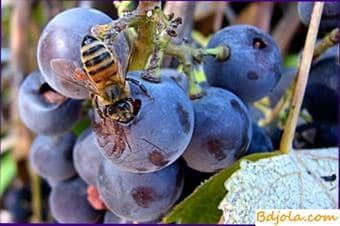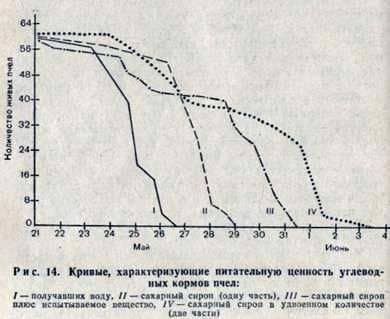Feeding bees treacle

To use sweet substances for feeding bees, it is necessary to know if bees are able to assimilate them, and if they are capable, then to what extent. There is a simple and sufficiently reliable method for assessing nutritional value for bees of carbohydrate feeds (sugars), soluble in water. For the experiment, bees are taken, if possible with empty honey cinders, and 50 pieces are placed in 4 cells. In the cells give the following food: in the first-clean water (control); in the second, a sugar solution (1: 1), counting on maintaining the life of the bees for about 3 days (20 cm3); in the third, the same sugar solution as for cell 2, but in a doubled quantity (40 cm3); in the fourth, a mixture consisting of a sugar solution in the same amount as for cell 2 (20 cm3) and an equal amount of a solution of the test substance dissolved in water 1: 1.
Bees feed on the food they have in their cells, and when they have consumed it, they perish. Daily counted and removed from the cells of dead bees. Then plot the number of live bees that are in cells for each day of the experiment.

The curves of the lifespan of the bees in the second and third cells serve as control for the curve of the fourth cell. If the test substance is not assimilated by the bees at all, then the curve of the fourth cell coincides with the curve of the second cell. If the test substance is nutritious for bees equal to sugar, then the curve of the fourth cell coincides with the curve of the third cell. With intermediate value, the curve of the fourth cell will occupy the middle position between the curves of the second and third cells.
Using the method described, E.
Phillips found out that bees absorb glucose and fructose from monosaccharides, but they do not assimilate galactose and mannose, from disaccharides-sucrose, maltose, and trehalose, but do
Birch and maple juice can be successfully applied for feeding bees in the early spring with birch and maple groves and forests near the apiary. However, the extraction of juice harms the tree, so it can be extracted only from trees that are to be cut down. The juice of birch contains 0.43-1.13%, and the maple – up to 2.5% of predominantly non-crystallizing sugar.
The extracted juice can be fed to the bees in fresh form, pouring into the drinking bowl. Bees very readily take the liquid when it flows over the board, somewhat thickening, evaporating the water under the influence of solar heat. The liquid easily wanders, so you need to wash the drinking bowl daily and pour fresh juice into it.
In order to better take the bees from the feeder, bees must be evaporated to a sugar content of 20-25%.
Feeding bees in early spring with condensed birch sap promotes brood growth.
Starch syrup from pure potato starch is quite acceptable for spring feeding of bees. It has an amber-golden color and sweet taste and is picked up by bees very willingly without any admixture of honey or sugar. However, bees can not hibernate on such a feed, since it contains 20.2-23.3% of substances not assimilated by bees.
Sugar marks (waste of the sugar industry) can be successfully used for the spring feeding of bees. Their value for bees depends on the degree of contamination. Under the name “sugar marks” sell waste of sugar-refined sugar (crumbs of pure sugar, contaminated with burlap, dust, etc.). This sugar is a good food for bees. From large mechanical impurities (fibers, straw, etc.), the syrup is purified during cooking, and the bees themselves clean it of fine impurities: by taking the syrup, they leave all the mechanical impurities on the bottom of the trough.
The scraps, sugar waste of the confectionery industry often contain starch and salt impurities. Small admixtures of starch in the spring, when bees fly, do not cause harm, but for winter such a food is completely unfit. With a large admixture of starch during the cooking of the syrup, a gelatinous mass is formed, which the bees do not take. The content of table salt should not exceed 0.5% of the amount of cooked syrup. With a higher concentration of salt, the bees do not take the syrup. For winter, even a minor admixture of table salt is unacceptable, since it leads to the death of bees.
In order to determine the suitability of the bees for feeding bees in the spring (in doubtful cases), a small amount of syrup should be welded in advance and tested on 2-3 bee families (bees will pick up sugar syrup from the feeders or not).
Juice of sugar sorghum. Some varieties of sorghum give juice, which bees are taken in a mixture with honey. In the autumn, the juice is squeezed out of the stems of sorghum and fed in fresh form, but for the wintering of bees, such food is not suitable.
Grapes.
In September, bees very willingly visit vineyards, points of reception and processing of grapes and take fresh grape juice. In the conditions of the south, bees can winter at the stern of grape juice.
Watermelon juice.
At the Maikop stronghold, we studied the wintering of bees on watermelon juice. To feed the juice, the watermelons were cut into two parts and the contents were stretched out by hand. Then halves with watermelon mash were placed in a sunny meadow near the apiary. Bees eagerly took watermelon juice. However, the families that wintered on this stern were killed. Therefore, watermelon juice can support the life of bees in autumn, but it is not suitable for wintering.
Feeding bees treacle
